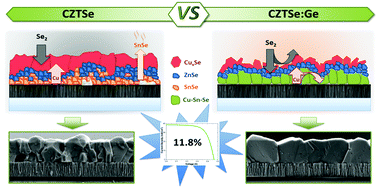当前位置:
X-MOL 学术
›
Energy Environ. Sci.
›
论文详情
Our official English website, www.x-mol.net, welcomes your
feedback! (Note: you will need to create a separate account there.)
How small amounts of Ge modify the formation pathways and crystallization of kesterites
Energy & Environmental Science ( IF 32.4 ) Pub Date : 2017-10-27 00:00:00 , DOI: 10.1039/c7ee02318a S. Giraldo 1, 2, 3, 4 , E. Saucedo 1, 2, 3, 4 , M. Neuschitzer 1, 2, 3, 4 , F. Oliva 1, 2, 3, 4 , M. Placidi 1, 2, 3, 4 , X. Alcobé 4, 5, 6, 7 , V. Izquierdo-Roca 1, 2, 3, 4 , S. Kim 8, 9, 10, 11 , H. Tampo 8, 9, 10, 11 , H. Shibata 8, 9, 10, 11 , A. Pérez-Rodríguez 1, 2, 3, 4, 12 , P. Pistor 1, 2, 3, 4, 13
Energy & Environmental Science ( IF 32.4 ) Pub Date : 2017-10-27 00:00:00 , DOI: 10.1039/c7ee02318a S. Giraldo 1, 2, 3, 4 , E. Saucedo 1, 2, 3, 4 , M. Neuschitzer 1, 2, 3, 4 , F. Oliva 1, 2, 3, 4 , M. Placidi 1, 2, 3, 4 , X. Alcobé 4, 5, 6, 7 , V. Izquierdo-Roca 1, 2, 3, 4 , S. Kim 8, 9, 10, 11 , H. Tampo 8, 9, 10, 11 , H. Shibata 8, 9, 10, 11 , A. Pérez-Rodríguez 1, 2, 3, 4, 12 , P. Pistor 1, 2, 3, 4, 13
Affiliation

|
The inclusion of Ge into the synthesis of Cu2ZnSn(S,Se)4 absorbers for kesterite solar cells has been proven to be a very efficient way to boost the device efficiency in a couple of recent publications. This highlights the importance to elucidate the mechanisms by which Ge improves the kesterite solar cells properties to such a large extent. In this contribution, we first show how controlling the position and thickness of a very thin (10–15 nm) layer of Ge greatly influences the crystallization of kesterite thin films prepared in a sequential process. Typically, Cu2ZnSnSe4 (CZTSe) films form in a bi-layer structure with large grains in the upper region and small grains at the back. By introducing Ge nanolayers below our precursors, we observe that large CZTSe grains extending over the whole absorber thickness are formed. Additionally, we observe that Ge induces fundamental changes in the formation mechanism of the kesterite absorber. In a detailed analysis of the phase evolution with and without Ge, we combine the results of X-ray fluorescence, X-ray diffraction and Raman spectroscopy to demonstrate how the Ge influences the preferred reaction scheme during the selenization. We reveal that the presence of Ge causes a large change in the in-depth elemental distribution, induces a stabilizing Cu–Sn intermixing, and thus prevents drastic compositional fluctuations during the annealing process. This finally leads to a change from a tri-molecular towards, mainly, a bi-molecular CZTSe formation mechanism. Kesterite thin films with surprisingly large crystals of several microns in diameter can be fabricated using this approach. The results are related to the increase in device performance, where power conversion efficiencies of up to 11.8% were obtained. Finally, the consequences of the disclosed crystallization pathways and the extension to other chalcogenide technologies are discussed.
中文翻译:

少量的锗如何改变钙钛矿的形成途径和结晶
在最近的几篇出版物中,已证明在合成钾盐的太阳能电池用Cu 2 ZnSn(S,Se)4吸收剂的合成中包含Ge是提高装置效率的非常有效的方法。这突出了阐明Ge在很大程度上改善硅藻土太阳能电池性能的机理的重要性。在这一贡献中,我们首先展示了如何控制非常薄(10–15 nm)的Ge层的位置和厚度如何极大地影响在顺序过程中制备的Kesterite薄膜的结晶。通常,Cu 2 ZnSnSe 4(CZTSe)薄膜形成双层结构,上部区域大颗粒,背面小颗粒。通过在我们的前驱物下面引入Ge纳米层,我们观察到形成了在整个吸收体厚度上延伸的大CZTSe晶粒。此外,我们观察到,Ge引起了硅藻土吸收剂形成机理的根本变化。在有或没有Ge的相演化的详细分析中,我们结合X射线荧光,X射线衍射和拉曼光谱的结果来证明Ge在硒化过程中如何影响优选的反应方案。我们发现,Ge的存在会引起深度元素分布的较大变化,引起稳定的Cu-Sn混合,从而防止退火过程中剧烈的成分波动。最终导致从三分子到主要是双分子CZTSe形成机理的改变。使用这种方法可以制造出直径惊人的大晶体(直径几微米)的钾钛矿薄膜。结果与设备性能的提高有关,其中功率转换效率高达11.8%。最后,讨论了所公开的结晶途径的后果以及对其他硫族化物技术的扩展。
更新日期:2017-10-27
中文翻译:

少量的锗如何改变钙钛矿的形成途径和结晶
在最近的几篇出版物中,已证明在合成钾盐的太阳能电池用Cu 2 ZnSn(S,Se)4吸收剂的合成中包含Ge是提高装置效率的非常有效的方法。这突出了阐明Ge在很大程度上改善硅藻土太阳能电池性能的机理的重要性。在这一贡献中,我们首先展示了如何控制非常薄(10–15 nm)的Ge层的位置和厚度如何极大地影响在顺序过程中制备的Kesterite薄膜的结晶。通常,Cu 2 ZnSnSe 4(CZTSe)薄膜形成双层结构,上部区域大颗粒,背面小颗粒。通过在我们的前驱物下面引入Ge纳米层,我们观察到形成了在整个吸收体厚度上延伸的大CZTSe晶粒。此外,我们观察到,Ge引起了硅藻土吸收剂形成机理的根本变化。在有或没有Ge的相演化的详细分析中,我们结合X射线荧光,X射线衍射和拉曼光谱的结果来证明Ge在硒化过程中如何影响优选的反应方案。我们发现,Ge的存在会引起深度元素分布的较大变化,引起稳定的Cu-Sn混合,从而防止退火过程中剧烈的成分波动。最终导致从三分子到主要是双分子CZTSe形成机理的改变。使用这种方法可以制造出直径惊人的大晶体(直径几微米)的钾钛矿薄膜。结果与设备性能的提高有关,其中功率转换效率高达11.8%。最后,讨论了所公开的结晶途径的后果以及对其他硫族化物技术的扩展。











































 京公网安备 11010802027423号
京公网安备 11010802027423号